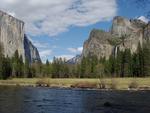Yosemite National Park has begun preparations for fall and winter prescribed fire and fuels projects. The fire program will send out formal announcements as ignition locations and dates are determined. Over 50 years of research has taught park managers that, in contrast to previous beliefs, total suppression of all fires does not prevent large severe wildfires. This tactic actually contributes to the proliferation of large severe wildfires, allowing unnatural levels of fuel to build up and burn unpredictably. Park managers now understand that fires are inevitable in this fire-adapted ecosystem, and working with fire is an effective way to protect resources. Prescribed fire, pile burning, mechanical thinning, and other fuels reduction projects are important techniques used to reduce excessive vegetation buildup on the landscape and reduce the potential for more severe fires.
Crane Flat Prescribed Fire
Crews are continuing preparation for a prescribed fire near Crane Flat lookout between the Tioga Road and Big Oak Flat Road. Crews will conduct pre-burn fuels treatments in this area to reduce the heavy accumulation of dead and down fuels prior to broadcast burning. The exact ignition date of this prescribed fire depends on a crucial mixture of weather, fuels moistures, and firefighter availability. Smoke impacts will be localized to the Crane Flat area during the day, however transient smoke will likely drift down canyon during the evening hours. Planned treatment: 670 acres.
Valley Prescribed Fire
Planning is in place for burning to occur in units east of El Capitan Crossover and at Ahwahnee Meadow. The exact ignition dates of these prescribed fires depend on a crucial mixture of weather, fuel moisture, and firefighter availability. Crews will conduct pre-burn fuels treatments in this area to reduce heavy accumulation of dead and down fuels prior to burning. Smoke will be localized to Yosemite Valley. Planned treatment: 380 acres
Mariposa Grove of Giant Sequoias
Fire managers are planning on continuing treatments in the Mariposa Grove of Giant Sequoias. Prescribed fire mimics natural ignition wildfires on the landscape and aids in the regeneration of giant sequoias. It also restores a more natural fire return interval keeping the ecosystem healthy and resilient. Crews may be observed conducting pre-burn vegetation treatments to reduce the heavy accumulation of dead and down fuels prior to broadcast burning. The exact ignition dates for sections in the grove are unknown. Smoke will be localized to the Mariposa Grove but may be observed from the community of Wawona. Planned treatment: 200 acres
Park Wide Pile Burning
Pile burning will continue throughout the park as conditions allow. Burning piles is an efficient and effective way to reduce excessive fuel build-up on the landscape. Mechanical thinning operations and landscape restoration projects produce burn piles throughout the park. Smoke from ignited piles will remain until each pile is completely consumed. Pile burning days will be announced in the Yosemite Daily Report. To sign up for these reports send an email to yose_daily_report@nps.gov
Fuels Projects
Mechanical fuels work will continue within park communities. These projects are ongoing and will mainly consist of cutting dead and down vegetation with chainsaws then piling it for future burning. You may see fuels crews and heavy equipment near residences. Please use caution around working fuels crews.
Smoke
Smoke will be present during prescribed fire operations. However, smoke produced during a prescribed fire is significantly less than if an unwanted wildfire occurs.
Yosemite National Park works closely with the park’s air quality specialists to calculate how much smoke may be produced based on the vegetation (fuel) type, number of acres, and meteorological conditions. Monitors are placed in areas that may see impacts from smoke. These monitors measure air quality levels in regard to public health. Managers will reduce ignitions or take appropriate action in response to unfavorable smoke impacts.
Fire managers work closely with local air pollution control districts to time the projects to coincide with favorable weather and smoke dispersion conditions. Smoke impacts are always a consideration in the decision to begin prescribed fire ignitions. A smoke management plan will be submitted and a burn permit will be issued for each project.
Prescribed Fire and Fuels Projects: Fall and Winter 2020-2021
All posts are those of the individual authors and the owner
of this site does not endorse them. Content should be considered opinion
and not fact until verified independently.
Sorry, only registered users may post in this forum.


